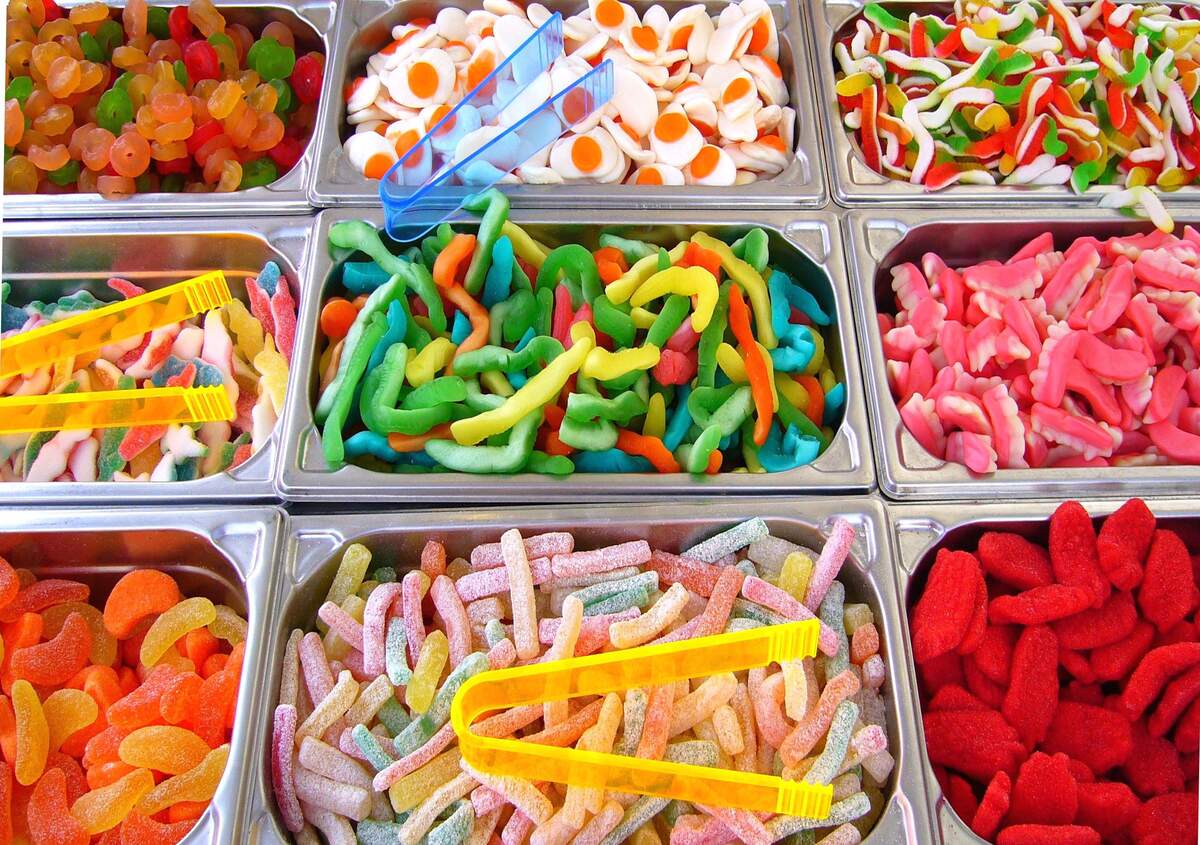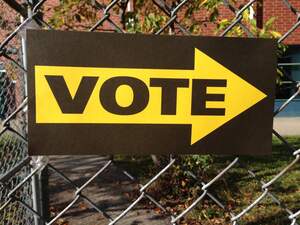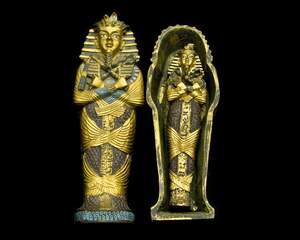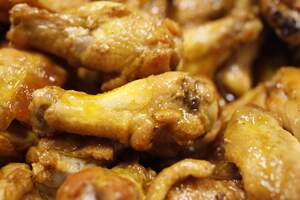

National Candy Day
You've been told again and again to not eat too much candy. However, today you can give in to your sweet tooth and eat as much as you want. Why? Because it's National Candy Day! Candy, confections which come in the form of bars, morsels, lozenges, and other figures, are usually eaten as a snack or treat and not during mealtime. They are made with sugar, syrup, or other sweet ingredients, and often contain chocolate, fruit, or nuts. Flour, eggs, milk, and natural and artificial flavorings are also commonly used to make candy.
Usually, sugar, or sucrose crystals, are dissolved into water to make candy. The duration of cooking and cooling of the sugar water, the heat it is cooked at, and the types of sweeteners, flavors, and other additives that are added determine the type of candy that is made. The hotter the sugar water becomes the more sugar can dissolve in it, and when the water begins to evaporate the syrup becomes highly concentrated. As it cools it becomes supersaturated with sugar. The sugar tries to recrystallize, but when it is cooled quickly it is prevented from doing so, and noncrystalline candies such as hard candy, lollipops, and caramel can be made. The adding of fructose and glucose can also help prevent crystallization.
There are a wide variety of types of candy. Chocolate is often referred to as candy on its own, and it is the most popular type, often being combined with other ingredients such as fruits and nuts. It is often used to make candy bars. Other common types of candy include hard candy, jelly beans, mints, taffy, caramels, lollipops, licorice, marshmallows, gummy candies, and sour candies.
The name "candy" is used much more often in the United States than elsewhere. It stems from a few archaic words. The Indian Sanskrit word khanda means "a piece of sugar," the Arabic word qandi or qand means "made of sugar," and the Old French word cucre candi or sucre candi means "cane sugar." The English word "candy" first appeared in 1475. It initially referred to toffee, a hard candy made from sugar and butter, but by the nineteenth century meant all types of sweet confections.
The forerunners of modern candy date to ancient times. Made of honey and spices, early candy was only available to the rich and was sometimes used as a medicine to soothe the throat or to calm the digestive system. Ancient Egyptians used honey to preserve fruits and nuts and to make marshmallows. The Greeks used honey for making candied flowers, stems, and fruits, and they also made a syrup out of figs and dates. A bit later, the Romans came up with a sweet treat called dulcia, which was made of dates stuffed with almonds and stewed with honey. In the Western Hemisphere, around 1200 BCE, the Olmec civilization of Mexico used cacao to make the world's first chocolate drink. The Mayans made the drink as well.
Sugar was largely unknown at the time. Indians were perhaps the first to use the sweet juice of sugarcane, around 1000 BCE. They were also the first to boil sugarcane juice to make brown sugar. However, it is possible that sugarcane may have been used by inhabitants of Papua New Guinea 3000 years prior. When Persian emperor Darius attacked India in 510 BCE, the army discovered sugarcane. Calling it "a reed that gives honey without the bees," the Persians worked with the Indians to export it around the world. By the early years of the Common Era, Indians were making candy with brown sugar, and even shaping it like animals and people. After the Arabs invaded in 642 CE, they took the brown sugar recipe, and it eventually became public domain, and sugar began spreading in the following centuries.
The Chinese began making confections with sugarcane, using it to sweeten ginger, licorice root, and nuts. By 950 CE, Arabs in the Middle East had invented caramel, and lozenges and marzipan came soon afterward. Sugar was brought to Europe during the Crusades, and candied fruits and boiled sugar candies began gaining in popularity. These candies were still mainly eaten by the wealthy.
Sugar became more available in the 1400s as its supply increased when Europeans began growing more of it. Although it became a little less expensive, it was still mainly the rich who ate candy. In the 1500s, the Spanish and Portuguese planted sugar in the West Indies and Brazil. They also found chocolate in the Americas, and sugar was added to it to cut its strong taste—chocolate eventually spread from Spain to the rest of Europe. In sixteenth-century Europe, candy manufacturing became more sophisticated, and boiled candy was molded with nuts and fruits. Boiled sugar candies or boiled "sugar plums"—hard candies—increased in popularity in seventeenth-century England and began appearing in the American colonies.
After learning about it from Native Americans, the American colonists enjoyed maple syrup and maple sugar and used it to make confections. This was especially popular in the North, while confections made from benne (sesame) seed were popular in the South. By the early eighteenth century, caramels were being enjoyed on the American continent, and by the 1780s, pralines and lollipops were being enjoyed there. Pralines became especially popular in New Orleans. By the turn of the nineteenth century, hard candies with lemon and peppermint flavors were in demand in the United States.
In the mid-1800s, increased sugar production and changing technology led to a revolution in the candy industry. Efficiency in production increased with the invention of the candy press and the revolving steam pan. Over 380 candy factories were in the United States at the time, and new types of candies continued to be made. New types from the time included peppermint sticks, chewy taffy, jawbreakers, vinegar candy, and gumdrops. In 1851, the Great Exhibition in London showcased "French-style" candies with rich cream centers, which then became popular in the United States. At the time, many candy factories made candy that was sold for a penny, appropriately named "penny candy." Penny candy was popular with all classes and especially loved by children. Often sold in batches or by the pound, and displayed behind glass cases, the price stayed at a penny until the early twentieth century.
Early chocolate candy bars were made by François-Louis Cailler in Switzerland in 1819. After milk chocolate was invented in 1875, it helped make the candy bar wildly popular in the late nineteenth century. The first milk chocolate candy bar in America was produced in 1894 by Milton Snavely Hershey: the Hershey's Milk Chocolate and Hershey's Milk Chocolate with Almonds bars. His bars were followed by hundreds of others, such as Milky Way, Snickers, Goo Goo Cluster, Mary Jane, and 3 Musketeers. The many bars included ingredients such as peanuts, caramel, cream, jellies, cookie wafers, fruit, nougat, coconut, and other fillings. Servicemen were given candy bars during World War I, and a candy-bar craze hit America following the war. The first candy bars sold for ten cents apiece, a very steep price at the time. Following World War I, the price of sugar and chocolate dropped, and the price of candy bars dropped to five cents apiece. This became the price of most candy bars until the 1960s. By 1968, the average cost of a candy bar was back up to ten cents, and in 1980 it was 35 cents.
People continued to eat other types of candy after Hershey's chocolate bars came out, and new types of candy continued to be made. Fudge was created in the late nineteenth century, getting its start in women's colleges. Cracker Jack was a hit at Chicago's World's Columbian Exposition in 1893, and jelly beans made their debut in 1905. Cotton candy, made by spinning colored sugar in a centrifuge, causing it to puff up into cotton-like strands, debuted around the turn of the twentieth century. It was—and still is—mostly sold at carnivals, circuses, and state fairs, but rarely at candy stores.
Early in the twentieth century, Americans went to "candy shops" to buy various types of candies, usually which were sold by the pound. Candy bars that were made in-house were often available as well. "Candy stores" were small shops that mostly sold commercially-produced and packaged candy, as well as items such as newspapers, ice cream sodas, and cigars—these stores were almost one and the same as the soda fountains and cigar stores of the era. Children also bought penny candy here, including, but certainly not limited to, malted-milk balls, strings of licorice, sweet liquids inside of small wax bottles, and hard pellets of candy stuck to long strips of paper. Countless new varieties and brands of candy continued to be created and sold throughout the twentieth century and into the twenty-first.
By 2010, Americans were consuming almost 25 pounds of candy a year. Sixty percent of candy sales were chocolate, and about 25 percent of candy sales took place around four holidays: Halloween, Christmas, Valentine's Day, and Easter. But we don't need to wait for one of those well-known holidays to come around. Today is National Candy Day, and we can buy and eat as much candy as we want!
How to Observe National Candy Day
Here are some ideas on how to make sure today's holiday is filled with sweetness:
- Visit a candy-themed place, such as Candytopia or Schimpff's Confectionary—a candy store that was opened in the nineteenth century that also has a candy museum.
- Take the Hershey's Chocolate Tour or visit another candy factory.
- Explore the website for the Candy Wrapper Museum.
- Watch a candy-filled film, such as Willie Wonka & The Chocolate Factory or Charlie and the Chocolate Factory.
- Listen to songs that have "candy" in their title.
- Make your own candy. You could pick up a copy of The Ultimate Candy Book: More than 700 Quick and Easy, Soft and Chewy, Hard and Crunchy Sweets and Treats or Candy Making Basics to help guide you.
- Read about the history of candy in books such as Sweets: A History of Candy or Candy: The Sweet History.
- Buy some candy, perhaps from a candy store. Then, enjoy!
You could try one of the candies mentioned in the holiday's description, or you could eat some of the following candies, which are some of the most popular of those that were created in the twentieth century (a few of these are no longer being made):
- Baby Ruth (1920): A chocolate-covered bar with a center of caramel and peanuts.
- Bit-O-Honey (1924): A bar made of almond bits and honey-flavored taffy.
- Charleston Chew (1922): A chocolate-covered bar with a vanilla-nougat center.
- Chunky (mid-1930s): A candy bar consisting of a square chunk of chocolate with Brazil nuts, cashews, and raisins.
- Clark (1917): A candy bar that contains roasted peanuts with a milk chocolate coating; usually called a "Clark bar."
- 5th Avenue (1936): A bar of peanut butter and almonds covered with milk chocolate.
- Heath Bar (1932): A chocolate-covered toffee bar.
- Hershey's Kisses (1907): Small chocolate drops wrapped in foil.
- Jujubes and Jujyfruits (1920).
- Junior Mints (1949): Small morsels with a creamy mint center covered with chocolate.
- Kit Kat (1937): A chocolate-covered biscuit bar; sections can be snapped off and eaten individually.
- Life Savers (1912): Round white peppermints with holes in the middle, which resembled life preservers on boats; more flavors were later added.
- M&M's (1941): Candy-coated chocolate drops that come in various colors.
- Mary Jane (1914): Molasses and peanut butter candy.
- Milk Duds (1926): Caramel and chocolate morsels.
- Milky Way (1923): A candy bar made of chocolate nougat and caramel, with a chocolate covering.
- Mounds (1922): A double bar of dark chocolate covering a coconut center.
- Mr. Goodbar (1925): A bar made of chocolate and peanut butter.
- Necco Wafers (1912).
- Oh Henry! (1921): A milk-chocolate and peanut bar.
- Reese's Peanut Butter Cups (1928): Round chocolate cups filled with peanut butter.
- Skittles (1974): Hard, sugar-coated and fruit-flavored nuggets.
- Sky Bar (1937): A combination bar consisting of segments containing centers of caramel, vanilla, peanut butter, and fudge.
- Snickers (1930): A bar of peanut butter nougat, peanuts in caramel, and a milk chocolate coating.
- Starburst (1960): A chewy, fruit-flavored candy in the shape of a cube.
- 3 Musketeers(1932): a bar with chocolate nougat; originally consisted of three bars of chocolate coating on top of fluffy chocolate, vanilla, and strawberry nougat.
- Tootsie Roll (1896): Chewy chocolate morsels.





















